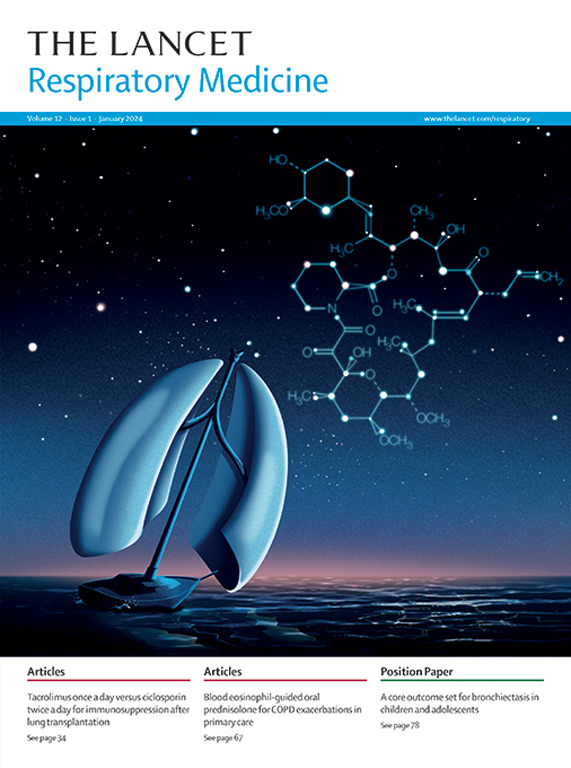Baseline characteristics of patients in the Chinese Bronchiectasis Registry (BE-China): a multicentre prospective cohort study
IF 38.7
1区 医学
Q1 CRITICAL CARE MEDICINE
引用次数: 0
Abstract
Background
Bronchiectasis is a disease with a global impact, but most published data come from high-income countries. We aimed to describe the clinical characteristics of patients with bronchiectasis in China.Methods
The Chinese Bronchiectasis Registry (BE-China) is a prospective, observational cohort enrolling patients from 111 hospitals in China. Data on demographics, comorbidities, and aetiological testing results were collected from adult patients with bronchiectasis at baseline and annual follow-up. Patients who met the inclusion criteria (age ≥18 years; received chest high-resolution CT in the past year showing bronchiectasis affecting one or more lung lobes; and clinical history consistent with bronchiectasis, including chronic cough, daily sputum production, and history of exacerbations) were included. Patients with known cystic fibrosis were excluded. To investigate variations according to different economic regions, two groups were compared based on whether per capita disposable income of residents was greater than US$5553. Clinical characteristics were compared with the European (EMBARC) registry and other national registries.Findings
Between Jan 10, 2020, and March 31, 2024, 10 324 patients from 97 centres were included in the study. Among 9501 participants with available data, the most common cause of bronchiectasis was post-infective disease (4101 [43·2%] patients), followed by idiopathic (2809 [29·6%] patients). 6676 (70·0%) of 9541 patients with available data had at least one exacerbation in the year before enrolment and 5427 (57·2%) of 9489 patients with available data were hospitalised at least once due to exacerbations. Treatments commonly used in high-income countries, such as inhaled antibiotics and macrolides, were infrequently used in China. Implementation of airway clearance in China was scarce, with only 1177 (12·2%) of 9647 patients having used at least one method of airway clearance. Compared with upper-middle-income regions, patients from lower-middle-income regions were younger (61·0 years [SD 14·0] vs 63·9 years [14·2]) with a higher proportion of pulmonary comorbidities (521 [17·8%] of 2922 patients vs 639 [8·6%] of 7402 with chronic obstructive pulmonary disease and 194 [6·6%] of 2922 patients vs 364 [4·9%] of 7402 patients with asthma), a higher tuberculosis burden (442 [16·0%] of 2768 patients vs 715 [10·6%] of 6733 patients), more severe radiological involvement (1160 [42·4%] of 2736 patients vs 2415 [35·4%] of 6816 patients with cystic bronchiectasis), more exacerbations (median 1·4 [IQR 0–2] in both groups; mean 1·4 [SD 1·6] vs 1·2 [1·4] in the previous year) and hospitalisations (1662 [60·6%] of 2743 patients vs 3765 [55·8%] of 6746 patients hospitalised at least once in the previous year), and poorer quality of life (median 57·4 [IQR 53·5–63·1] vs 58·7 [54·8–64·8] assessed by the Bronchiectasis Health Questionnaire).Interpretation
The clinical characteristics of patients with bronchiectasis in China show differences compared with cohorts in Europe and India. Bronchiectasis is more severe with a higher burden of exacerbations in lower-income regions. The management of patients with bronchiectasis in China urgently needs standardisation and improvement.Funding
National Natural Science Foundation of China, Innovation Program of the Shanghai Municipal Education Commission, Program of the Shanghai Municipal Science and Technology Commission, and Program of the Shanghai Shenkang Development Center.Translation
For the Chinese translation of the abstract see Supplementary Materials section.中国支气管扩张登记(BE-China)患者的基线特征:一项多中心前瞻性队列研究
背景:支气管扩张是一种影响全球的疾病,但大多数已发表的数据来自高收入国家。我们的目的是描述中国支气管扩张患者的临床特征。方法中国支气管扩张登记(BE-China)是一项前瞻性观察队列研究,纳入了来自中国111家医院的患者。在基线和年度随访中收集成年支气管扩张患者的人口统计学数据、合并症和病因学检测结果。符合纳入标准的患者(年龄≥18岁;过去一年接受胸部高分辨率CT检查,显示支气管扩张影响一个或多个肺叶;包括与支气管扩张相一致的临床病史(包括慢性咳嗽、每日痰量和加重史)。排除已知囊性纤维化的患者。为了调查不同经济区域的差异,根据居民人均可支配收入是否大于5553美元对两组进行了比较。临床特征与欧洲(EMBARC)登记处和其他国家登记处进行比较。在2020年1月10日至2024年3月31日期间,来自97个中心的10324名患者被纳入研究。在9501名有资料的参与者中,最常见的支气管扩张原因是感染后疾病(4101例[43.2%]),其次是特发性疾病(2809例[29.6%])。9541例可获得数据的患者中有6676例(70%)在入组前一年至少有一次病情加重,9489例可获得数据的患者中有5427例(57.2%)因病情加重至少住院一次。高收入国家常用的治疗方法,如吸入抗生素和大环内酯类药物,在中国很少使用。中国实施气道清除的情况很少,9647例患者中只有1177例(12.2%)使用了至少一种气道清除方法。与中高收入地区相比,中低收入地区患者更年轻(66.1岁[SD 14.0]对63.9岁[14.2]),肺部合合症比例更高(2922例慢性阻塞性肺病患者中521例[17.8%]对7402例慢性阻塞性肺病患者中639例[8.6%],2922例哮喘患者中194例[6.6%]对7402例哮喘患者中364例[4.9%]),结核病负担更高(2768例患者中442例[16.0%]对6733例患者中715例[10.6%])。更严重的影像学损害(2736例患者中1160例[42.4%]vs 6816例患者中2415例[35.4%]),更严重的加重(两组中位数为1.4 [IQR 0-2];平均1.4[标准差1.6]比上一年的1.2[1.4])和住院(2743例患者中1662例[66%]比上一年至少住院一次的6746例患者中3765例[55.8%]),以及较差的生活质量(经支气管扩张健康问卷评估的中位数57.4 [IQR 55.3 - 63.1]比58.7[58.4 - 68.4])。与欧洲和印度的队列相比,中国支气管扩张患者的临床特征存在差异。支气管扩张在低收入地区更为严重,加重负担更高。中国支气管扩张患者的管理急需规范和改进。国家自然科学基金、上海市教委创新项目、上海市科学技术委员会项目、上海申康发展中心项目。摘要的中文译文见补充资料部分。
本文章由计算机程序翻译,如有差异,请以英文原文为准。
求助全文
约1分钟内获得全文
求助全文
来源期刊

Lancet Respiratory Medicine
RESPIRATORY SYSTEM-RESPIRATORY SYSTEM
CiteScore
87.10
自引率
0.70%
发文量
572
期刊介绍:
The Lancet Respiratory Medicine is a renowned journal specializing in respiratory medicine and critical care. Our publication features original research that aims to advocate for change or shed light on clinical practices in the field. Additionally, we provide informative reviews on various topics related to respiratory medicine and critical care, ensuring a comprehensive coverage of the subject.
The journal covers a wide range of topics including but not limited to asthma, acute respiratory distress syndrome (ARDS), chronic obstructive pulmonary disease (COPD), tobacco control, intensive care medicine, lung cancer, cystic fibrosis, pneumonia, sarcoidosis, sepsis, mesothelioma, sleep medicine, thoracic and reconstructive surgery, tuberculosis, palliative medicine, influenza, pulmonary hypertension, pulmonary vascular disease, and respiratory infections. By encompassing such a broad spectrum of subjects, we strive to address the diverse needs and interests of our readership.
 求助内容:
求助内容: 应助结果提醒方式:
应助结果提醒方式:


